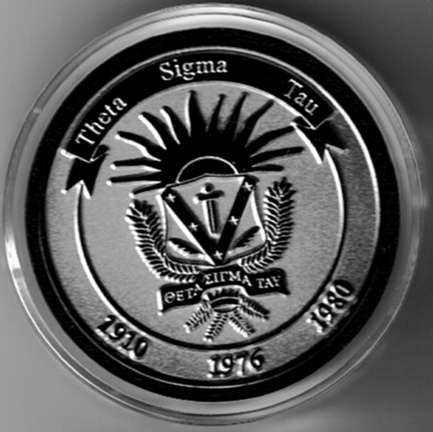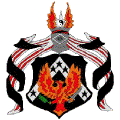  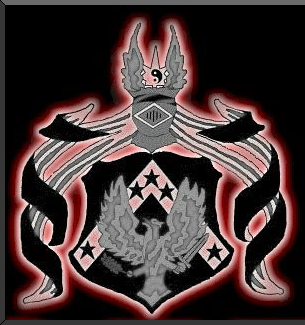
|
|||||||
|
Theta Sigma Tau Challenge Coin A Table of Contents / FAQ
Why a challenge coin for Tau? The idea of creating a challenge coin was suggested on the Alumni Exploder and a large number of active and alumni members took an interest. The idea of a token symbolizing membership and connection with other members (as well as a reason to scam drinks off of forgetful brethren) was very appealing. Over the period of several weeks a coin design was generated by an informal committee formed of active members and alumni. Design ideas were suggested and voted upon until a final version was approved by all of those that were involved. A little shopping around was done and an on-line business that specializes in the creation of custom coins and medallions was selected. Once they completed the design to the members' specifications (also done by vote) the coin was officially commissioned. Pete Lenz ('89) fronted the money to pay for the initial order of coins and at the same time he began taking orders from alumni and actives who were interested in having one (or more) coins. Nearly 70 coins from the first order of 150 coins were designated as donor coins by our very generous alumni (and a couple of actives). The majority of these coins were used to ensure that every active member at the 2006 Spring Formal received a coin and that pledges since then have received a coin upon activation (a generous alumnus contributed several hundred dollars in 2010 to ensure that this tradition could continue). Several of the coins were designated to be gifted to the house's faculty advisors, past and present. Several others were designated to be incorporated into plaques commemorating those Taus that have passed away since the reformation of the house in 1976. Coins will continue to be available through the Alumni Association until further notice. What does the Theta Sigma Tau Challenge Coin look like?
The images below are the final art designed by the vendor for use in creating the dies used to stamp the coins. What you see is exactly what the coins look like. With the detail that the original images provide (they are too large to post here) one can see that the very tiny yin yang symbol at the top of the newer crest is intact and looks good.
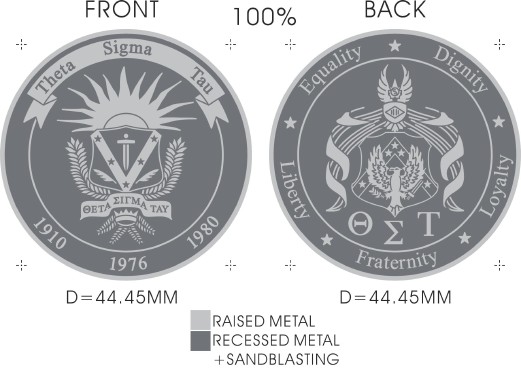
Below are scans of a coin (in a hard plastic protective case with a black foam rubber surround) to give you a fair idea of what the coins look like. The detail is as good as in the artwork (above). The raised portions are mirror-like shiny surfaces while the lowered portions have a matte finish. The detail items, such as the yin yang on the reverse and the leaves on the laurel branches on both sides, are excellent. Click on either image to open a new window with a larger version of the image.
A written description:
The coin is made of a metal that is silvery in appearance and will be 1.75" in diameter. There will not be a mint date on it... they will all be equal to each other, regardless of the date upon which they were minted... just as the membership are all considered to be equals regardless of age, gender, race, etc. Who is eligible to have/obtain a coin? With regard to who may voluntarily obtain a coin:
Coins may be awarded by alumni to non-members that are affiliated with the house in some way. Only an alum may gift a challenge coin to a non-member. Non-members to whom coins may be gifted should be limited to:
What are the rules and customs revolving around the coin? Quite obviously, the rather elaborate rules noted in the History of Challenge Coins (below) detailing the origin of the challenge coin are a bit much. To date, the following guidelines have been suggested:
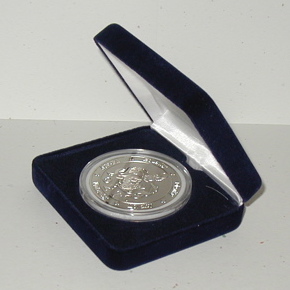
How much does a coin cost? The price is $15/coin. This price is lower than many challenge coins tend to run (usually upwards of $20) and will still permit the Alumni Association to bank a slight bit of cash (approx. $4/coin) which will be used to facilitate future orders of the Challenge Coin or other activities/expenses of the Alumni Association (like this website, for example). Coins come in a soft, transparent plastic sleeve. For an additional $1, one can purchase a hard plastic case (pictured above) that will better protect the coin. The case is slightly oversized in diameter, but there is a foam spacer to ensure that the coin is held in position. This spacer can be white or black, at the choice of the purchaser. These cases can be purchased separately at a later date. A small display stand (like an artist's easel) is available for another $1. It is designed to work with the hard plastic case and is made of the same type of material. If one wishes additional protection, or to be able to display the coin in a nice setting, one can purchase a blue velvet or black leatherette display box designed to hold the hard plastic case noted above. Either box is $7.50, a price that includes the hard case.
To order a coin for yourself or to be donated to someone else:
All prices and charges are just a little more than the cost to the Alumni Association: we're not in this to make money. The small amount of profit will be used to defray the costs associated with maintaining the House and Alumni websites ($100/year for the server) and will also be used towards additional orders of these coins. If you have questions, email Plenz and ask away. So... what IS a challenge coin? A Challenge Coin is a coin-shaped token that represents membership in a group or organization. The original concept of a Challenge coin is as follows (the veracity of this story may be questionable... some of the details sound a bit too contrived). During World War I, a lieutenant from a wealthy family ordered medallions struck in solid bronze and presented them to his air squadron. One young pilot placed the medallion in a small leather pouch that he wore about his neck. Some time after acquiring the medallion, the pilot's aircraft was severely damaged by enemy fire. He was forced to land behind enemy lines and was captured by a German patrol. In order to discourage his escape, the Germans took all of his personal identification except for the small leather pouch around his neck. Taking advantage of a bombardment that night, he escaped... but without personal identification. He managed to avoid German patrols by dressing in civilian clothing and succeeded in reaching the front lines. He finally came upon a French outpost. Unfortunately, saboteurs had been plaguing the French in that area, sometimes masquerading as civilians. Because he had no identification and the French being unable to recognize the young pilot's American accent, they suspected him of being a saboteur. As the French discussed their options, the leading one being to shoot him as an enemy combatant, the airman showed his medallion to his French captors, one of whom recognized the squadron insignia on the medallion. They delayed his execution long enough for him to confirm his identity. Instead of shooting him they gave him a bottle of wine.
Back at his squadron, it became tradition to ensure that all members carried their medallion or coin at all times. This was accomplished through challenge in the following manner - a challenger would ask to see the medallion. If the challenged person could not produce a medallion, they were required to buy a drink of choice for the member who challenged them. If the challenged member produced a medallion, then the challenging member was required to pay for the drink. This tradition continued on throughout the war and for many years after the war while surviving members of the squadron were still alive.
The website of the US Air Force Wire Dawgs lists the rules and traditions that surround their own challenge coin, these seem to be somewhat commonly held traditions:
The Challenge Coin concept moved out of military circles and was adopted by many kinds of organizations and clubs, including fraternities and sororities. Even Sigma Nu has this tradition, as a quick search of eBay will show the occasional Sigma Nu Challenge Coin up for auction. |
|||||||||||||||||||||
| Fun Stuff | Roll Call | Memory Lane | Members Only | Home | ||||||
|---|---|---|---|---|---|---|---|---|---|---|
|
Exploder
Forum Newsletters Store Challenge Coin |
Alumni
AA Officers Family Trees Yearbooks |
Our Creed
History Traditions Relics Scrapbook Centennial Definitions |
τ-Tunes LGBTQI Relics Traditions |
Home
Donate Contact Site Map |
||||||
©2007, 2022 Peter W. Lenz, All rights reserved.
